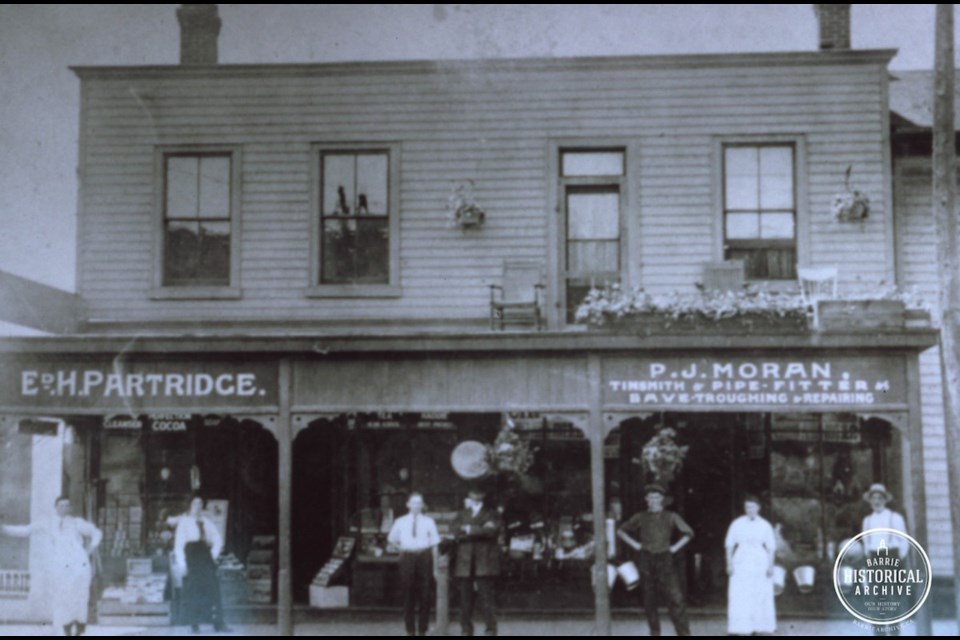“Victoria Stove Depot – In New Quarters!”
George C. Buck, tinsmith and owner of the business, had been selling stoves, hammering out eaves troughing and repairing metal work out of his old-fashioned frame shop near Five Points for a number of years. He must have been rather excited to announce his move to a new venue in a smart modern brick building on the south side of Dunlop Street near the railway station.
When he ordered that ad to run in the Oct. 5, 1876 edition of the Northern Advance, he may have thought himself lucky that his old wooden shop on Bayfield Street had somehow been spared when the Simcoe Hotel, and all of the buildings adjoining it up to Collier Street, had been burned to the ground earlier that year. Indeed, his former shop would succumb to flames in 1877, taking the original Wellington Hotel and a few others with it.
However, George Buck, 33 years old, married father and fast rising star in the circle of Barrie merchants, was already dead by the time the ad appeared. He simply failed to wake up one morning and the inquest that followed determined that he had died from natural causes, likely of the cardiac variety.
Changes came suddenly to the fabric of downtown Barrie then, and they continue to happen today. The Five Points intersection, the heart of old Barrie, has been losing its points for quite a few years now, each one lost to fire. It was inevitable that something would eventually fill those vacant spots.
With the necessary approvals complete, or seemingly nearly so, a tower of some 20 storeys is set to rise in the place where the Wellington Hotel fell just over 10 years ago.
Not much remains of from the 19th century in the stretch of Bayfield Street up to Ross Street now. Three quarters of the block was converted into modern shopping places decades ago, with the opening of Loblaw’s (now the bingo hall), and of Woolworth’s (now the Ranch country bar). All that is left is a small portion of the brick block that extended from the Wellington Hotel to an alley way that separates it from the Lennox Building at 40 Bayfield St.
Boarded up since just after the 2007 blaze, that lone brick structure closest to Five Points will surely be torn down to make way for the new condominium building. I wonder where that leaves the Lennox Building? If saved, it would be the only Victorian remaining in the block, so I am hopeful but not terribly optimistic.
Thomas Lennox came from an Innisfil farming family. He decided that he would like to be a merchant in the booming town of Barrie and so brought his family here about 1871, when the population was 3,000 citizens. Thomas Lennox must have known of Barrie’s tendency to ignite, and so he made the unusual and not inexpensive decision to build his shop from brick. When the destructive fire of 1877 turned most of his neighbours’ shops to ashes, his remained largely intact.
Lennox’s Bayfield Street Grocery sold wine, teas, groceries and provisions, and proudly proclaimed that his goods “cannot be beaten either for quality or price.”
The Bayfield Street Grocery operated within a long and varied business block, much like the ones that line Dunlop Street today, with neigbouring merchants that included George Buck, George Smith Furniture Emporium near Ross Street, Raymer’s Harness Shop next door to the Wellington Hotel, and later Partridge Grocer and P.J. Moran Tinsmith. Hard to imagine now.
Thomas Lennox gave up the shop by the late 1890s and retired to Bracebridge where he died in 1910. By then, his old shop had been painted over and ‘Coffey Hardware’ emblazoned on the southern wall. Many years later, that paint was blasted away to reveal the original red brick once again. Also visible again, in faint white painted letters, is ‘Lennox Provisions’. Have a look – while you still can.
Each week, the Barrie Historical Archive provides BarrieToday readers with a glimpse of the city’s past. This unique column features photos and stories from years gone by and is sure to appeal to the historian in each of us.



